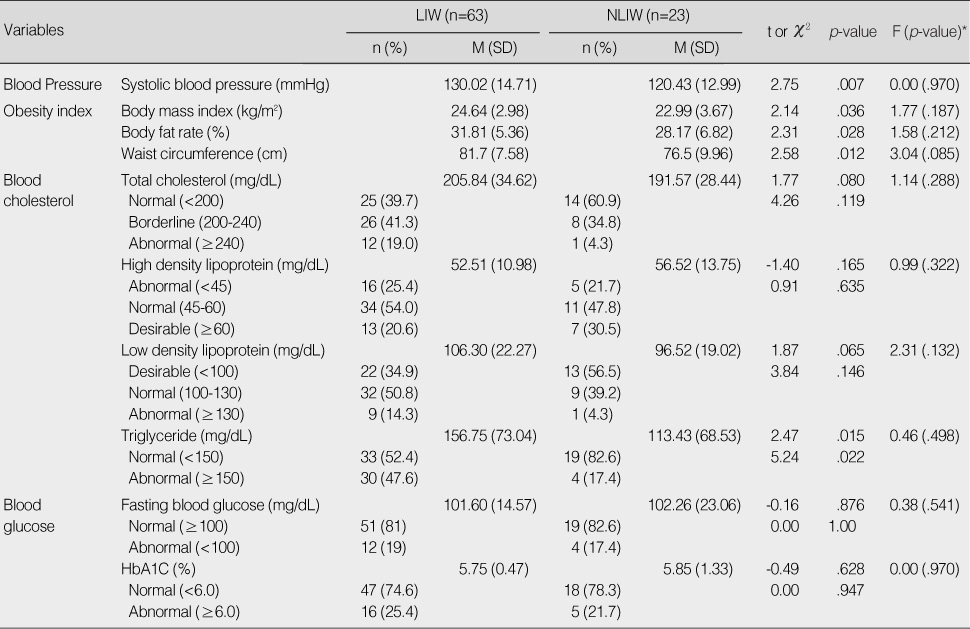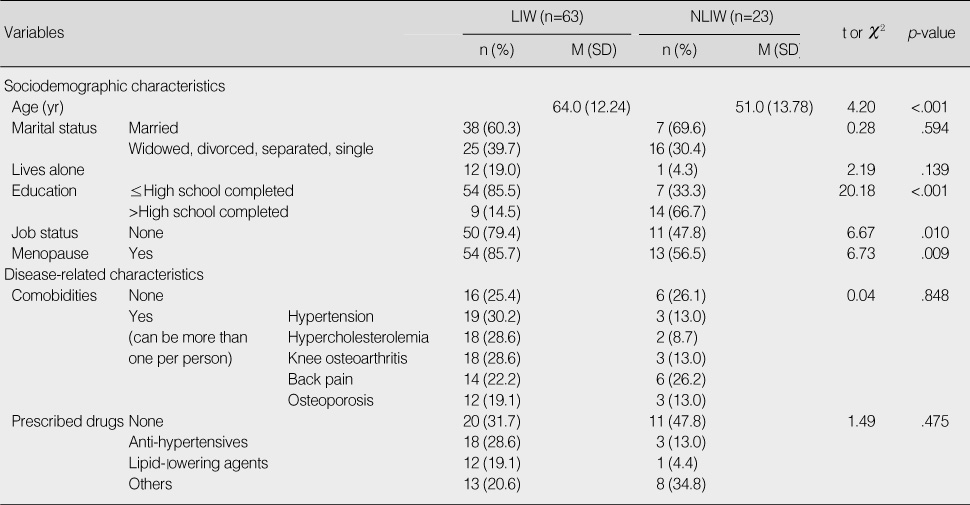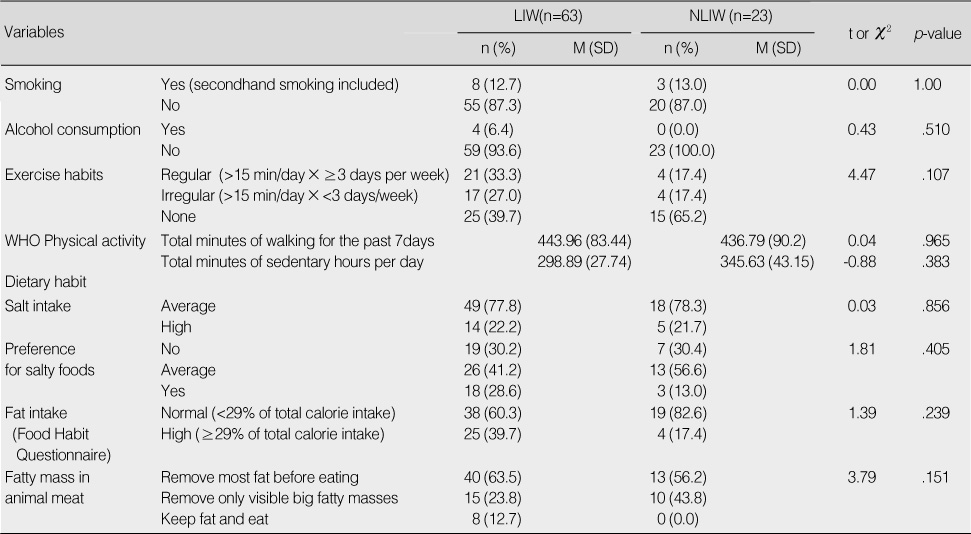Articles
- Page Path
- HOME > J Korean Acad Nurs > Volume 40(6); 2010 > Article
-
Original Article
- Comparison of Cardiovascular Health Status and Health Behaviors in Korean Women based on Household Income
- Young-Joo Park, Nah-Mee Shin, Ji-Won Yoon, Jiwon Choi, Sook-Ja Lee
-
Journal of Korean Academy of Nursing 2010;40(6):831-843.
DOI: https://doi.org/10.4040/jkan.2010.40.6.831
Published online: December 31, 2010
1Professor, College of Nursing, Korea University, Seoul, Korea.
2Assistant Professor, College of Nursing, Korea University, Seoul, Korea.
3Full-time Instructor, Department of Nursing, Suwon Women's College, Suwon, Korea.
4Adjunct Assistant Professor, University of California, San Francisco, School of Nursing, San Francisco, USA.
5Professor, College of Nursing, Korea University, Seoul, Korea.
- Address reprint requests to: Shin, Nah-Mee. Assistant Professor, College of Nursing, Korea University 126-1 Anam-dong 5-ga, Seongbuk-gu, Seoul 136-701, Korea. Tel: 82-10-2795-1602, Fax: 82-2-927-4676, nshin@korea.ac.kr
Copyright © 2010 Korean Society of Nursing Science
Abstract
-
Purpose
- In this study cardiovascular health status and health behavior of Korean women based on their household income were explored.
-
Methods
- For this cross-sectional study, 91 women residing in the community were recruited to complete survey questionnaires and biophysical tests including blood pressure (BP), body mass index (BMI), body fat rate, waist circumference (WC), and blood chemistry tests.
-
Results
- Compared to non-low income women (NLIW), low income women (LIW) were more likely to be older, less educated, and jobless, and further more LIW were postmenopause and reported having been diagnosed with hypertension or hypercholesterolemia. Significant differences were found in systolic BP, triglyceride level, BMI, body fat rate, and WC between the groups. Two fifths of the LIW had indications for metabolic syndrome. Their 10-yr risk estimate of myocardioal infarction or coronary death demonstrated a higher probability than that of NLIW. Although these significant differences were due to age gap between the groups, advanced age is known to be one of the key characteristics of LIW as well as a non-modifiable risk factor.
-
Conclusion
- Effective community programs for vulnerable women at risk of cardiovascular disease should be based on strategies targeting unhealthy behaviors and modifiable risk factors.
This study was funded by the Korea Institute for Health and Social affairs, Management Center for Health Promotion (General 09-46) and the Korea University Research Fund for New Faculty.
- 1. Ahn S, Kim H, So H, Song R. Factors influencing fear of falling in postmenopausal women. Korean Journal of Women Health Nursing. 2009;15:344–352.Article
- 2. American Heart Association. Heart and stroke facts: 2010 Statistical supplement. 2010;Dallas, Texas, Author.
- 3. Choi JW, Wilbur JE, Miller A, Szalacha L, McAuley E. Correlates of leisure-time physical activity in Korean immigrant women. Western Journal of Nursing Research. 2008;30:620–638.ArticlePubMedPDF
- 4. Craig CL, Marshall AL, Sjostrom M, Bauman AE, Booth ML, Ainsworth BE, et al. International physical activity questionnaire: 12-country reliability and validity. Medicine and Science in Sports and Exercise. 2003;35:1381–1395.ArticlePubMed
- 5. Dixon TB, Lim LL, Powell H, Fisher JD. Psychosocial experiences of cardiac patients in early recovery: A community-based study. Journal of Advanced Nursing. 2000;31(6):1368–1375.ArticlePubMed
- 6. Grundy SM. Metabolic syndrome scientific statement by the american heart association and the national heart, lung, and blood institute. Arteriosclerosis, Thrombosis, and Vascular Biology. 2005;25:2243–2244.ArticlePubMed
- 7. Ham OK, Kim BJ, Lee YA. Cardiovascular disease risk according to socioeconomic factors among low-income midlife women. Journal of Korean Academy of Public Health Nursing. 2008;22:27–38.
- 8. Ju K, So H. Effects of the nutrition education program on self-efficacy, diet behavior pattern and cardiovascular risk factors for the patients with cardiovascular disease. Journal of Korean Academy of Nursing. 2008;38:64–73.ArticlePubMed
- 9. Kim S, Sohn C, Chung WY. Effects of medical nutrition therapy on food habits and serum lipid levels of hypercholesterolemic patients. Journal of the Korean Dietetic Association. 2005;11:125–132.
- 10. Kim TM, Juon HS, Hill MN, Post W, Kim KB. Cardiovascular disease risk factors in Korean American elderly. Western Journal of Nursing Research. 2001;23:269–282.ArticlePubMedPDF
- 11. Korea Institute for Health and Social Affairs. 2005 National Health and Nutrition Survey. 2006;Seoul, Ministry of Health and Welfare.
- 12. Korea National Statistical Office. Annual report of the cause of death. 2005;Seoul, Author.
- 13. Korea National Statistical Office. Annual report of the causes of death. 2008;Seoul, Author.
- 14. Kristal AR, Shattuck AL, Henry HJ. Patterns of dietary behavior associated with selecting diets low in fat: Reliability and validity of a behavioral approach to dietary assessment. Journal of the American Dietetic Association. 1990;90:214–220.ArticlePubMed
- 15. Lee DY, Rhee EJ, Choi ES, Kim JH, Won JC, Park CY, et al. Comparison of the predictability of cardiovascular disease risk according to different metabolic syndrome criteria of aha/nhlbi and international diabetes federation in Korean men. Korean Diabetes Journal. 2008;32:317–327.
- 16. Lee S, Park H, Kim S, Kwon H, Kim D, Kim D, et al. Cut-off points of waist circumference for defining abdominal obesity in the Korean population. Korean Journal of Obesity. 2006;15:1–9.
- 17. Job package for the low income class. Ministry of Employment & Labor. 2010;Retrieved September 24, 2010. from http://www.moel.go.kr/policyinfo/bizpack/user/sub_02_01.jsp.
- 18. Mok O, Kang J, Kim H, Nam J, Kwon S, Cho J, et al. Obesity control strategies based on epidemiologic characteristics of Korean obesity. 2001;Retrieved September 1, 2009. from http://www.ndsl.kr/bridge.do.
- 19. Murdaugh C. Coronary artery disease in women. Journal of Cardiovascular Nursing. 1990;4:35–60.Article
- 20. Diet modification. National Hypertension Center. 2005;Retrieved May 15, 2009. from http://www.hypertension.or.kr/viewC.php?vCode=305001.
- 21. Expert Panel on Detection, Evaluation, and Treatment of High Blood Cholesterol in Adults. Executive summary of the third report of the National Cholesterol Education Program (NCEP): Expert panel on detection, evaluation, & treatment of high blood cholesterol in adults [Adult Treatment Panel III]. Journal of the American Medical Association. 2001;285:2486–2497.PubMed
- 22. Park IS, Song R, Ahn S, So HY, Kim HL, Joo KO. Factors explaining quality of life in individuals with coronaryartery disease. Journal of Korean Academy of Nursing. 2008;38:866–873.ArticlePubMed
- 23. Park SK, Kim H, Cho IS, Ham OK. Gender differences in factors influencing quality of life among patients with coronary artery disease. Journal of Korean Academy of Fundamentals Nursing. 2009;16:497–505.
- 24. Shin N, Hagerty B, Williams R. Gender comparison in depressive symptoms and use of antidepressant medications following acute coronary syndrome. Applied Nursing Research. 2010;23:73–79.ArticlePubMed
- 25. So AY, Kim YM, Kim EY, Kim CY, Kim CH, Kim HG, et al. Effects of community-based case management program for clients with hypertension. Journal of Korean Academy of Nursing. 2008;38:822–830.ArticlePubMed
- 26. Son YJ. Development and effects of an integrated symptom management program for prevention of recurrent cardiac events after percutaneous coronary intervention. Journal of Korean Academy of Nursing. 2008;38:217–228.PubMed
- 27. Song R, Ahn S, So H, Park I, Kim H, Joo K, et al. Effects of Tai Chi exercise on cardiovascular risk factors and quality of life in post-menopausal women. Journal of Korean Academy of Nursing. 2009;39:136–144.ArticlePubMed
- 28. Song Y. Analyses of studies on cardiac rehabilitation for patients with cardiovascular disease in Korea. Journal of Korean Academy of Nursing. 2009;39:311–320.ArticlePubMed
- 29. Taylor-Piliae RE. Tai Chi as an adjunct to cardiac rehabilitation exercise training. Journal of Cardiopulmonary Rehabilitation. 2003;23:90–96.ArticlePubMed
- 30. Yoo JS, Jeong JI, Park CG, Kang SW, Ahn JA. Impact of life style characteristics on prevalence risk of metabolic syndrome. Journal of Korean Academy of Nursing. 2009;39:594–601.ArticlePubMed
REFERENCES


Figure & Data
REFERENCES
Citations

- Cardiometabolic Risk of Visceral Fat Obesity and Factors Influencing Visceral Fat in Overweight or Obese Middle-Aged Korean Women: A Cross-Sectional Study
Sujin Kim, Nah-Mee Shin, Jiwon Choi
Korean Journal of Adult Nursing.2024; 36(4): 320. CrossRef - Health promoting behaviors in low-income overweight and obese women in Korea: an exploratory qualitative study
Ju-Hee Nho, Eun Jin Kim
Korean Journal of Women Health Nursing.2021; 27(4): 348. CrossRef - Socioeconomic Disparities in Cardiovascular Health in South Korea
Chi-Young Lee, Eun-Ok Im
Journal of Cardiovascular Nursing.2021; 36(1): 8. CrossRef - Measurement of Socioeconomic Position in Research on Cardiovascular Health Disparities in Korea: A Systematic Review
Chi-Young Lee, Yong-Hwan Lee
Journal of Preventive Medicine and Public Health.2019; 52(5): 281. CrossRef - A Pilot Study of APN-led Self-management Program to Improve Cardiovascular Health Status among Korean Women with Risk Factors
Nah-Mee Shin, Ji-Won Yoon, Jiwon Choi, Younghee Park, Songi Jeon
Korean Journal of Adult Nursing.2016; 28(2): 237. CrossRef - A Study on the Health and Nutritional Characteristics according to Household Income and Obesity in Korean Adults Aged over 50 -Based on 2005 KNHANES-
So Hyun Ahn, Sook Mee Son, Hye Kyeong Kim
Korean Journal of Community Nutrition.2012; 17(4): 463. CrossRef
Comparison of the Biophysical Indicators between Low Income Women and Non-Low Income Women (N=86)
*by ANCOVA with age as the controlling factor.
Sociodemographic and Disease-related Characteristics of Low Income Women and Non-Low Income Women (N=86)
LIW=low income women; NLIW=non-low income women.
Prevalence of Metabolic Syndrome and Estimate of 10-Year Risk of Myocardial Infarction and Coronary Death
*by ANCOVA with age as the controlling factor.
MI=myocardial infarction.
Comparison of Health related Lifestyle Factors etween Low Income Women and Non-Low Income Women
LIW=low income women; NLIW=non-low income women.
*by ANCOVA with age as the controlling factor.
LIW=low income women; NLIW=non-low income women.
*by ANCOVA with age as the controlling factor. MI=myocardial infarction.
LIW=low income women; NLIW=non-low income women.
 KSNS
KSNS
 E-SUBMISSION
E-SUBMISSION


 Cite
Cite

